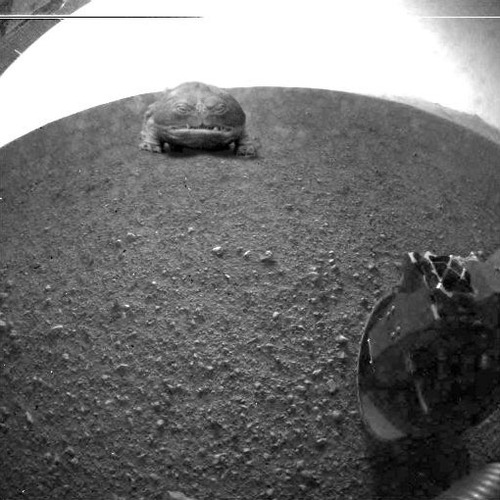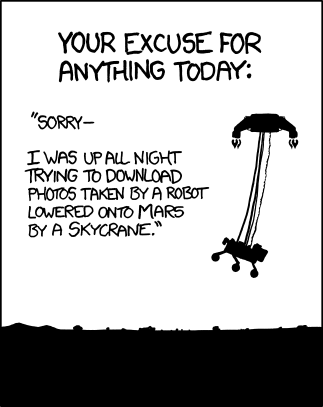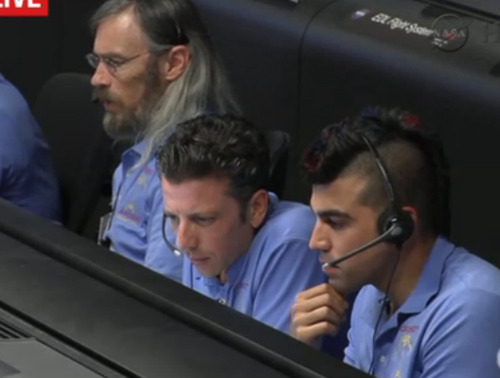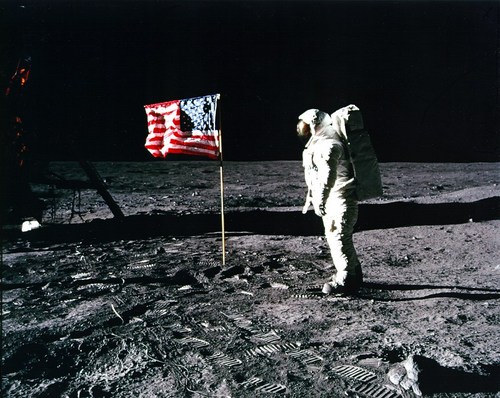
When I awoke last Friday morning, I thought I’d missed all the fun already, and would have to content myself with a YouTube replay of the Dragon spacecraft arriving at the International Space Station. But whether because I miscalculated my time zones (always a possibility; I can never figure out how Utah’s daylight savings time works with the other zones) or because the Dragon’s approach was delayed by a small problem with its laser rangefinding device, it turned out that I was in fact just in time to watch live as the ISS grappled the spacecraft with its robotic arm.
(If you haven’t followed the coverage closely, I should explain, briefly, that Dragon was not allowed to maneuver into the ISS’s docking port under its own power, as the space shuttle used to. Rather, it closed to within a certain distance and matched speeds with the station, so it appeared from the ISS to be standing still, and then the ISS reached out and grabbed hold of the capsule with the Canadarm2 manipulator, which, as you can see in the image above, is a beefier version of the Canadian-built robot arm used aboard the shuttles. After holding the Dragon for a time while some final checks were made, the multi-jointed arm then pulled the capsule down to a port where it was made secure with latching bolts. This operation is called “berthing,” as opposed to “docking,” which involves some different hardware and techniques.)
I must confess, my expectations of how this sort of thing is supposed to look have been honed by countless sci-fi movies and TV shows, which rarely waste precious screentime on what usually amounts to an establishing shot as far as the plot is concerned. Which means fictional spacecraft meeting up with each other are usually depicted as moving with the same mundane carelessness as a city bus pulling to the curb. But in real life, the process is much more cautious and methodical, i.e., everything… moves… very… slow…ly… And that means I got a wee bit impatient before it was all over. At one point, it appeared as if the grappling head had stopped moving altogether, and when the voice of mission control announced that there was only half a meter’s distance remaining — a mere foot and a half — I actually yelled at my monitor something to the effect of, “Oh, come on!” But at last the grapple snapped down over the fixture on the side of the capsule, and the historic message came down from the ISS: “Looks like we’ve got a Dragon by the tail.” And I felt a warm glow of cheer spread through my chest that I haven’t felt since the space shuttle Discovery blasted off on her post-Columbia disaster “return to flight” mission.
I had to switch off the computer at that point and get to work, and by the time I reached the office, Dragon was berthed. I intended to blog my thoughts about the event then, but naturally it was a busy day at work, as it always seems to be when something is going on that I really want to write about (it’s almost as if The Man knows). And a busy day led to a busy three-day weekend that blurred into another busy week. Meanwhile, high above our heads, the ISS crew had opened the connecting hatches and reported that Dragon had a “new-car smell” and looked “like a sci-fi filmset” inside, with its blue LED lights marking the deck (as opposed to the walls, difficult to distinguish when you’re floating in zero-g), before getting busy unloading the 1,100 pounds of food, water, clothing and equipment she’d brought up. This cargo was replaced with over 1,300 pounds of used equipment and other items scheduled for return to Earth, the first time the ISS has been able to send anything back since the last shuttle flight a year ago.
And then early yesterday morning, after nine days in space that seemed to pass with astonishing speed (at least from my perspective), Dragon was pushed away from the station by the Canadarm2, fired her thrusters to begin decelerating, and re-entered the atmosphere for a controlled splashdown in the Pacific Ocean, a little under 600 miles west of Baja California. For old-timers and space buffs who know their history, the scene looked like a return to the glory days of Apollo, with the scorched capsule descending beneath fat, red-and-white-striped parachutes. Today, she’s on a barge that will return her to Long Beach, California. The capsule will need to be thoroughly inspected, of course, but as of right now, it looks like the mission was a flawless success, aside from that one glitch with the rangefinder. The demonstration phase is over; SpaceX has proven it’s up for the job of supporting the space station, and now hopes to fly the first of twelve contracted cargo runs to the ISS as early as this summer. Looking a little farther down the road, the plan is to fly the first humans aboard a Dragon capsule in 2015.
I’m sure everyone who doesn’t live and breathe this stuff is sick of hearing it, since every news article has said the same thing, but this point must be emphasized again: this mission was historic, as much so in its way as the Mercury missions or the first space shuttle flight. This was the first time a private company did what has previously been the sole province of national governments: they designed, built, and successfully demonstrated both a booster rocket and a functioning, useful spacecraft. Yes, NASA provided some seed money and the parameters to follow, but SpaceX, and in particular the company’s founder Elon Musk, essentially did this on their own. And while there are several other private companies aiming for the same goal, SpaceX got there first. A plucky little company comprising fewer than 2,000 employees, mostly enthusiastic young people from what I can see, has brought us into the age of commercial space travel. It’s a great story. And you know, as much as I love my space shuttles and wish there was still a role for them up there, even if it’s a much-reduced one from what they previously enjoyed, I’m overjoyed about this development. It means that somebody still wants to go up there and has the will to do it. And it opens up… possibilities. As depressed as I was about our future in space only a few months ago, today I am hopeful. Hopeful that in only a few short years, the skies will be filled with spacecraft — manned, reusable spacecraft — from a dozen private-industry firms, and that NASA is back in the big-idea business, and maybe, just maybe, the public gives a damn again about seeing what’s over the horizon…








